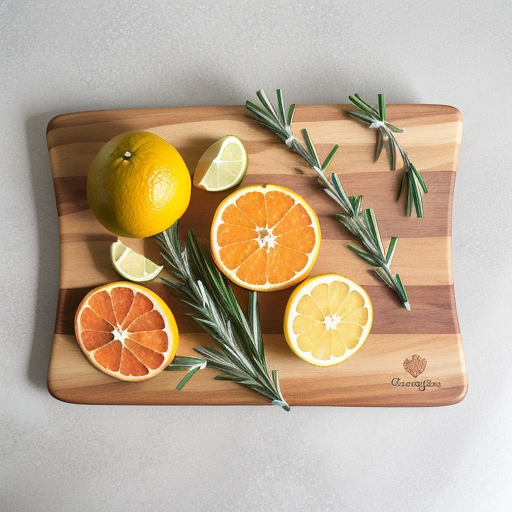As an Amazon Associate I earn from qualifying purchases.
Kitchen cutting boards are a prep essential no home cook can live without. A good cutting board makes slicing, dicing, and chopping easy while protecting your knives and countertops. With so many materials to choose from like plastic, glass, and bamboo, why opt for a wooden cutting board?
Wood has natural advantages that make it the best material for cutting boards used daily. Wood’s slight softness is actually knife-friendly compared to harder surfaces that dull blades. Wood also has an attractive, classic appearance that enhances any kitchen decor.
But not all woods are equal when it comes to cutting boards. The type of wood impacts durability, maintenance needs, safety, and aesthetics. In this comprehensive guide, we’ll compare what is the best wood for cutting boards and discuss key selection criteria.
The Benefits of Wooden Cutting Boards
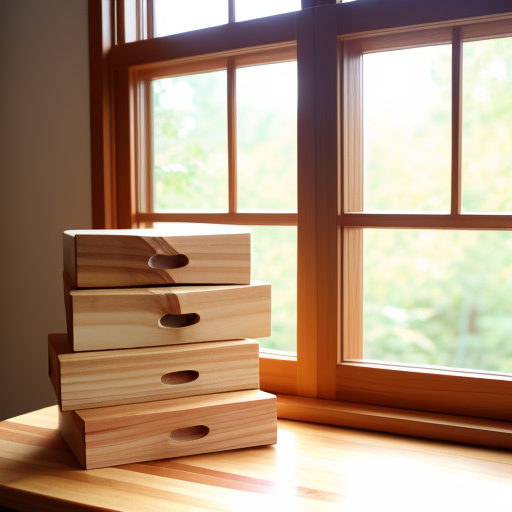
Before diving into specific woods, let’s look at why wood is such a popular cutting board material:
Superior knife protection – The slight give of wood is gentle on knife edges compared to materials like glass or stone. Wood allows the blade to sink in slightly rather than abrade on the surface. This preserves your knives’ sharpness.
Resists bacteria – Contrary to popular belief, wood has natural antiviral and antimicrobial properties that make it exceptionally sanitary. Studies show wooden boards harbor far less bacteria than plastic boards. The wood grain does not hold onto bacteria the way plastic scoring and grooves can.
Learn more about the sanitary properties of wood cutting boards.
Stays put – Quality wooden boards are heavy enough to remain firmly planted on your countertop during use. Lighter plastic boards tend to slide around, creating a safety hazard.
Doesn’t dull knives – Dense woods won’t dull or damage knives the way some materials like glass or ceramic can. The right wood allows the knife to sink in while still providing enough resistance for a good cutting action.
Looks fantastic – A gorgeous wooden cutting board can become a statement piece in your kitchen. Woods like walnut and maple display beautiful natural grain patterns that complement any decor.
Options for every budget – Wood boards come in a very wide range of prices. Inexpensive boards made from woods like birch provide great functionality on a budget, while pricier exotic woods make impressive gifts.
Now that we’ve covered the overall benefits of wood cutting boards, let’s look at how to choose the best wood type for your needs.
Factors for Evaluating Wood Cutting Boards
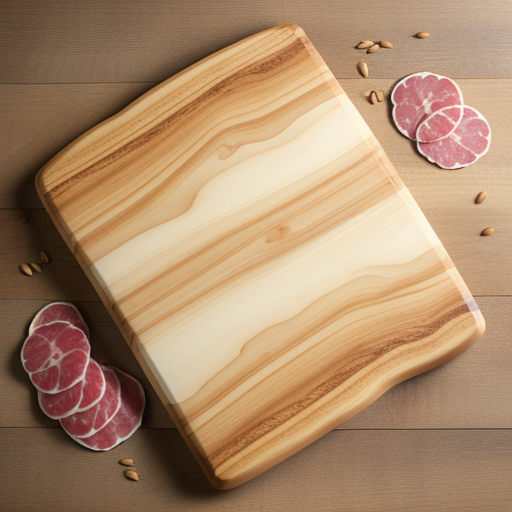
Not all woods perform equally when made into cutting boards. The wood species determines traits like:
- Durability – Will it resist knife marks and wear from repeated use?
- Maintenance – How much upkeep does it need in terms of oiling and cleaning?
- Safety – Is it non-toxic and naturally antimicrobial?
- Appearance – Does it have an attractive grain pattern and coloration?
By weighing these factors, we can compare wood types and determine which are best suited for cutting boards that perform well and look great. Let’s look at each factor in-depth:
Durability
The ideal wood for a cutting board is extremely hard and dense. This prevents the constant chopping motion from digging into the wood over time. Dense woods also resist absorbing stains, odors, and moisture that can warp boards.
A key indicator of wood density is the Janka hardness scale. This measures the force required to embed a steel ball half-way through a sample of wood. Higher Janka scores indicate denser, harder woods.
While very hard woods like ebony (rating of 3,160) are too tough on knives for cutting boards, you want a hardwood in the 1,000 to 1,500 Janka range. This provides an optimal balance of durability while still being gentle on your blades.
Some examples of durable hardwoods suitable for cutting boards include:
- Maple (1,450 Janka)
- Walnut (1,010 Janka)
- Teak (1,070 Janka)
- Cherry (950 Janka)
Softwoods like pine and cedar have a Janka rating around 350-400 and scratch easily. They aren’t durable enough for cutting boards used frequently.
Maintenance
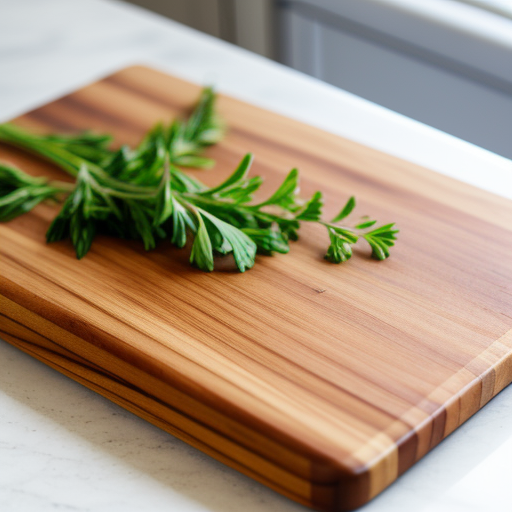
A good cutting board wood should require very little maintenance in your kitchen. You don’t want to be oiling a board daily or scrubbing it for ages to remove stains.
Lower maintenance woods have natural oils or closed grains that limit how much liquid and grime they absorb. Oily woods like teak naturally resist water, while dense closed-grain woods like maple don’t drink up stains.
Ideally a cutting board should only need light oiling every few weeks to maintain its condition. Occasional deeper conditioning maintains the wood’s natural moisture and prevents drying or cracks.
Higher maintenance woods like walnut and cherry absorb more oil and liquid. They require additional upkeep to maintain their condition and appearance.
Safety
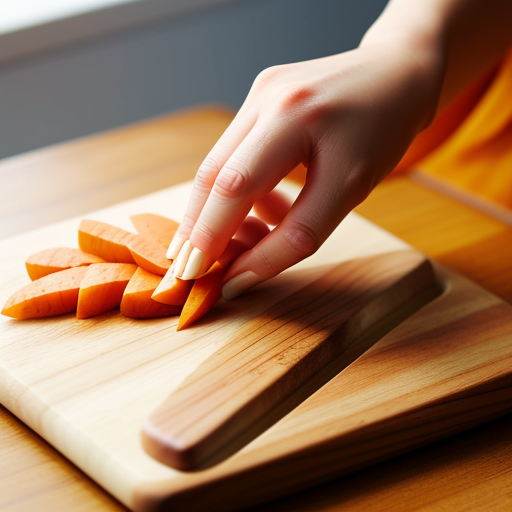
When choosing a cutting board, you want wood free from harmful chemicals or toxins that could leach into food. Avoid woods like chemically treated pine that contain toxic compounds in their finish.
Also consider woods with natural antimicrobial properties. Some woods contain compounds that inhibit bacterial growth. This reduces the risk of cross-contamination from meats and other foods.
Teak, maple, and walnut cutting boards have well-documented antimicrobial effects. In contrast, more porous woods allow bacteria to hide away in tiny crevices and cracks.
Appearance
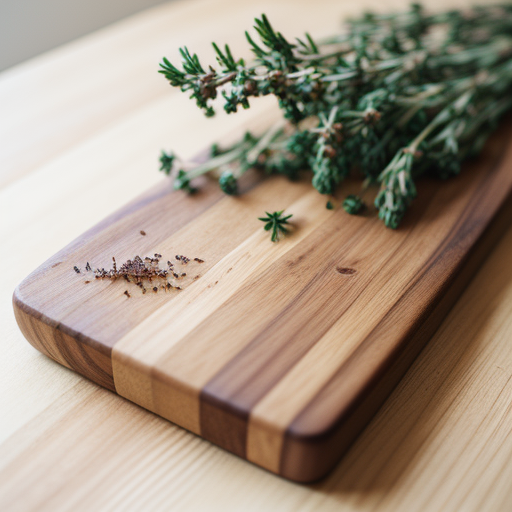
Aesthetics matter too when selecting a kitchen cutting board! You want wood with an attractive, natural grain pattern that brightens up your countertop. Woods with distinctive colors or visual styles can become statement pieces.
Maple displays nice blonde coloring and fine grain patterns. Teak has a warm golden-brown hue with coarse, oily grains. Walnut shows off varying chocolate brown tones and flowing grain shapes.
While beauty is subjective, well-finished boards in eye-catching species certainly make prep work more pleasant. Exotic and imported woods also add global flair to any kitchen decor.
What Is The Best Wood For Cutting Boards ? The 5
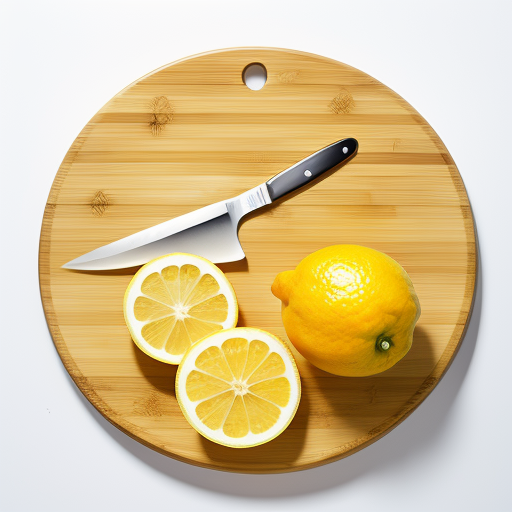
Now that we’ve covered how to assess cutting board woods, let’s look at five of the best species for residential kitchens:
1. Maple
Maple is one of the most popular and readily available woods for cutting boards. Hard Canadian maple provides the ultimate balance of hardness, beauty, and affordability.
Durability – With a Janka rating of 1,450, rock maple is extremely hard and dense. This prevents knife marks and long-term wear and tear. The fine, close grain creates a smooth, resilient surface.
Maintenance – Maple requires very little maintenance if properly cured. An occasional light oiling is all that’s needed to maintain optimal conditions. Maple doesn’t easily stain or absorb odors either.
Safety – Maple is FDA approved as safe for direct food contact. The tight grain gives bacteria nowhere to hide. Maple cutting boards have strong antibacterial properties.
Appearance – The pale blonde hue and smooth, even grain result in a clean, attractive look. Stains can create fun patterns as well. Many boards include juice grooves to catch run-off liquids.
Maple satisfies every requirement for the ideal cutting board wood. It has just the right balance of hardness and yield for a cutting surface that preserves blades. The smooth grain and light coloring make a timeless cutting board perfect for any kitchen.
From inexpensive maple boards for daily use to thick, hearty maple butcher blocks, there’s a maple cutting board for every need and budget.
2. Teak
Teak wood is coveted for its natural water and moisture resistance. This tropical hardwood has unique properties that make it perfect for low-maintenance cutting boards.
Durability – With a Janka hardness rating of 1,070, teak can withstand plenty of slicing and dicing. The oily wood grains hold up well to repeated knife use without excessive marking.
Maintenance – One of teak’s biggest assets is its weather-resistance. The wood’s high oil content creates a natural barrier against moisture, spills, and stains. Little maintenance is required beyond rinsing clean.
Safety – In addition to being food-safe when cured, teak has natural antibacterial compounds to inhibit microbial growth. These help reduce contamination risk when prepping foods.
Appearance – Teak has a distinctive coarse, oily grain with colors ranging from golden brown to almost black. The wood develops a charming silvery-grey patina over time with use.
If you want a durable, care-free cutting board, choose teak. Its uniqueness and water-resistance make it well suited for kitchen use. Teak offers a great alternative for those seeking something beyond basic maple boards.
Many teak boards include helpful features like hand grips or juice grooves. The wood’s hardness does require occasional resurfacing to maintain an even cutting surface over time. But with minimal upkeep needs, teak is a great option for lazy cooks!
3. Walnut
Prized for its rich chocolate hues and bold grain patterns, walnut wood makes for visually striking cutting boards. Walnut’s hardness provides great durability for heavy prep work.
Durability – With a Janka rating of 1,010, walnut is slightly softer than maple but still holds up very well to slicing and chopping tasks. The wood’s density prevents excessive marking over time.
Maintenance – Walnut boards require more maintenance than maple. The wood needs periodic oiling to maintain moisture levels and prevent drying out. Walnut is somewhat prone to staining as well.
Safety – Walnut contains natural antibacterial compounds called juglones. These inhibit the growth of dangerous bacteria like salmonella and E. coli on the board’s surface.
Appearance – Walnut displays varying chocolate and caramel tones in chaotic swirling patterns. The bold grains create visual interest. Walnut darkens further with conditioning treatments.
Walnut makes a refined, upscale statement in any kitchen. The striking colors and grain make this a top choice for decorative boards and statement pieces. Carved or inlaid walnut boards can become family heirlooms.
The wood does require a bit more care to maintain its beauty compared to maple. But walnut’s aesthetic qualities make the extra effort worthwhile for many users. It’s easy to see why walnut cutting boards are prized worldwide.
4. Cherry
Known for its warm reddish hues and fine grain, cherry wood is a nice choice for cutting boards seeking a rich color profile. The wood darkens further over time.
Durability – With a Janka hardness rating of 950, cherry is dense enough for prep work but will gradually show knife marks with heavy use. It’s not quite as wear-resistant as maple or walnut.
Maintenance – Routine oiling is required to keep cherry cutting boards from drying out. Letting the wood dry leaves it prone to cracking. Cherry also stains easily if not cleaned thoroughly after use.
Safety – When properly cured, cherry wood presents no health hazards. It does not have innate antibacterial properties though, so thorough cleaning is recommended after use.
Appearance – The fine, straight cherry grain results in a smooth surface texture. Colors range from golden brown to deep reddish browns. Cherry will continue to patina over its lifetime.
Cherry’s warm hues and refinement make it suitable for upscale kitchens. The wood provides a nice balance of visual interest without being too loud. But cherry performs best when supplemented with harder boards for heavy-duty chopping. It’s too soft for an all-purpose board.
5. Bamboo
Bamboo has become a popular eco-friendly option for cutting boards. Technically classified as a grass rather than wood, bamboo has some stellar properties for kitchen use.
Durability – With a Janka hardness rating of 1,380, bamboo is even denser than maple. It resists knife markings incredibly well over time. Properly cured bamboo is very durable under repetitive cutting stresses.
Maintenance – Thanks to its density, bamboo absorbs very little moisture. Simply cleaning with mild soap and water is sufficient for maintenance. Re-oiling is needed far less often than with most woods.
Safety – Bamboo has innate antibacterial properties from the silica within its fibers. This helps reduce contamination when prepping foods. Proper heat-treating eliminates toxins.
Appearance – Bamboo has a uniform honey-yellow color lacking distinctive grain. The segmented chunks of bamboo stems provide visual interest. Bamboo gives off an organic, natural vibe.
Bamboo makes an excellent starter cutting board for novice cooks or secondary board for other tasks. It’s incredibly durable and easy to care for. The grass is also highly renewable and eco-friendly compared to exotic tropical woods.
While not as visually striking as wood, bamboo has become trendy for its sustainability factor and performance. Bamboo holds up astonishingly well over years of use and abuse. Just avoid low-quality bamboo boards prone to splitting or splintering.
Learn more about whether bamboo makes a good cutting board material.
Tips for Buying and Caring for Wood Cutting Boards

Now that you know how to select the right wood species, here are some additional tips for purchasing and maintaining wood cutting boards:
- Opt for end-grain or edge-grain boards over cheaper flat-grain boards. End-grain distributes knife stresses best.
- Use very thick boards of at least 2 inches for prep work to allow knives to sink in safely.
- Handwash boards rather than dishwashing to prevent drying out the wood. Avoid excess water exposure.
- Oil or wax boards regularly with food-grade mineral oil. This maintains optimal moisture levels in the wood.
- Allow boards to fully dry lying flat before standing vertically or bacteria may grow in moisture.
- Routinely inspect boards for deep cracks, warping, or other signs of needed replacement.
- Consider using separate boards for meat/fish and produce to reduce cross-contamination risks.
- Don’t cut directly on board surfaces. Always use a cutting mat or sheet first to prevent marking.
With proper care, a quality wood cutting board can serve faithfully for many years of chopping, slicing, and dicing. Follow these tips and the top wood species outlined above to choose boards that stay beautiful and functional.
Do you have any personal favorites when it comes to wood cutting boards? Share your experiences selecting and caring for wood boards in the comments below!
As an Amazon Associate I earn from qualifying purchases.

